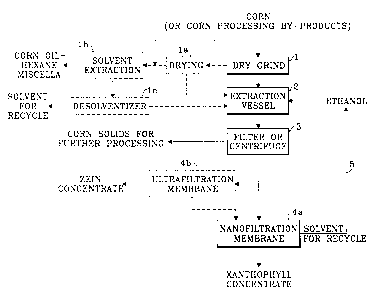Some of the information on this Web page has been provided by external sources. The Government of Canada is not responsible for the accuracy, reliability or currency of the information supplied by external sources. Users wishing to rely upon this information should consult directly with the source of the information. Content provided by external sources is not subject to official languages, privacy and accessibility requirements.
Any discrepancies in the text and image of the Claims and Abstract are due to differing posting times. Text of the Claims and Abstract are posted:
| (12) Patent: | (11) CA 2426757 |
|---|---|
| (54) English Title: | METHOD FOR EXTRACTING XANTHOPHYLLS FROM CORN |
| (54) French Title: | METHODE D'EXTRACTION DE PIGMENTS XANTHOPHYLLES DU MAIS |
| Status: | Term Expired - Post Grant Beyond Limit |
| (51) International Patent Classification (IPC): |
|
|---|---|
| (72) Inventors : |
|
| (73) Owners : |
|
| (71) Applicants : |
|
| (74) Agent: | PERLEY-ROBERTSON, HILL & MCDOUGALL LLP |
| (74) Associate agent: | |
| (45) Issued: | 2006-12-19 |
| (86) PCT Filing Date: | 2000-10-25 |
| (87) Open to Public Inspection: | 2002-05-02 |
| Examination requested: | 2003-04-23 |
| Availability of licence: | N/A |
| Dedicated to the Public: | N/A |
| (25) Language of filing: | English |
| Patent Cooperation Treaty (PCT): | Yes |
|---|---|
| (86) PCT Filing Number: | PCT/US2000/041552 |
| (87) International Publication Number: | US2000041552 |
| (85) National Entry: | 2003-04-23 |
| (30) Application Priority Data: | None |
|---|
The method of the invention uses raw corn, or a corn by-product as a source.
The source is mixed with an alcohol (2) to produce an alcohol-corn slurry.
Centrifugation or filtration (3) produces a clear filtrate from the alcohol-
corn slurry. A membrane filtration (4a) step is then used to separate purified
xanthophylls. Other steps may be combined with the basic process to produce
additional corn products, such as oil and zein.
L'invention concerne une méthode utilisant du maïs ou un produit dérivé du maïs comme source. Cette source est mélangée avec un alcool (2) pour produire une suspension épaisse à base d'alcool et de maïs. Après centrifugation et filtration (3) de la suspension épaisse, on obtient un filtrat clair. On procède ensuite à une filtration sur membrane (4a) pour séparer les pigments xanthophylles purifiés. D'autres étapes peuvent être combinées avec le procédé de base pour produire des produits supplémentaires à base de maïs, telle que de l'huile et de la zéine.
Note: Claims are shown in the official language in which they were submitted.
Note: Descriptions are shown in the official language in which they were submitted.

2024-08-01:As part of the Next Generation Patents (NGP) transition, the Canadian Patents Database (CPD) now contains a more detailed Event History, which replicates the Event Log of our new back-office solution.
Please note that "Inactive:" events refers to events no longer in use in our new back-office solution.
For a clearer understanding of the status of the application/patent presented on this page, the site Disclaimer , as well as the definitions for Patent , Event History , Maintenance Fee and Payment History should be consulted.
| Description | Date |
|---|---|
| Inactive: Expired (new Act pat) | 2020-10-26 |
| Common Representative Appointed | 2019-10-30 |
| Common Representative Appointed | 2019-10-30 |
| Inactive: Late MF processed | 2015-11-02 |
| Letter Sent | 2015-10-26 |
| Inactive: Late MF processed | 2015-01-26 |
| Letter Sent | 2014-10-27 |
| Inactive: Late MF processed | 2012-03-19 |
| Letter Sent | 2011-10-25 |
| Inactive: Late MF processed | 2009-10-30 |
| Letter Sent | 2009-10-26 |
| Grant by Issuance | 2006-12-19 |
| Inactive: Cover page published | 2006-12-18 |
| Inactive: Final fee received | 2006-09-22 |
| Pre-grant | 2006-09-22 |
| Notice of Allowance is Issued | 2006-08-02 |
| Letter Sent | 2006-08-02 |
| Notice of Allowance is Issued | 2006-08-02 |
| Inactive: IPC assigned | 2006-04-27 |
| Inactive: IPC assigned | 2006-04-27 |
| Inactive: IPC from MCD | 2006-03-12 |
| Inactive: IPC removed | 2006-02-28 |
| Inactive: First IPC assigned | 2006-02-28 |
| Inactive: IPC assigned | 2006-02-28 |
| Inactive: Approved for allowance (AFA) | 2005-10-31 |
| Amendment Received - Voluntary Amendment | 2005-05-31 |
| Inactive: S.30(2) Rules - Examiner requisition | 2004-12-21 |
| Amendment Received - Voluntary Amendment | 2003-10-14 |
| Inactive: Cover page published | 2003-06-25 |
| Inactive: First IPC assigned | 2003-06-18 |
| Letter Sent | 2003-06-18 |
| Letter Sent | 2003-06-18 |
| Inactive: Acknowledgment of national entry - RFE | 2003-06-18 |
| Application Received - PCT | 2003-05-27 |
| National Entry Requirements Determined Compliant | 2003-04-23 |
| Request for Examination Requirements Determined Compliant | 2003-04-23 |
| All Requirements for Examination Determined Compliant | 2003-04-23 |
| Application Published (Open to Public Inspection) | 2002-05-02 |
There is no abandonment history.
The last payment was received on 2006-10-04
Note : If the full payment has not been received on or before the date indicated, a further fee may be required which may be one of the following
Patent fees are adjusted on the 1st of January every year. The amounts above are the current amounts if received by December 31 of the current year.
Please refer to the CIPO
Patent Fees
web page to see all current fee amounts.
Note: Records showing the ownership history in alphabetical order.
| Current Owners on Record |
|---|
| THE BOARD OF TRUSTEES OF THE UNIVERSITY OF ILLINOIS |
| Past Owners on Record |
|---|
| MUNIR CHERYAN |